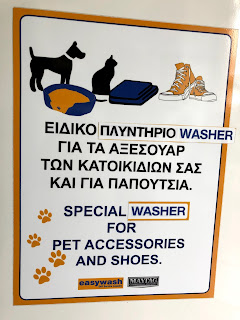 |
 |
| Kavala Old Town gives sweeping views of the city |
Kavala is a city jammed between the mountains behind it and the sea in front so there is
 |
| Couldn't get much closer to the sea |
 |
| The 16th century aqueduct was still in use 400 years later |
As well as the French we were sharing our spot with a colony of cats who, we discovered,
 |
| Early morning view...plus cat |
The following morning we discovered a small park, perched precariously on a rocky mound behind the law courts which was good enough to walk the pups. When we got back we were informed by one of our French neighbours that the police had popped in and told them to move the following morning. We had, in any case, decided to move on that afternoon as we wanted to get to Thessaloniki where we had identified a convenient laundrette, and we had found a place to overnight not too far from that city.
 |
| Kavala is sat on a beautiful bay |
 |
| The laundrette catered for everyone |
The plan had been to visit a laundrette on the south of the city. We had chosen Sunday morning believing that the Greek law closing all shops on the Sabbath might allow us to find somewhere to park. We were disappointed. Having squeezed our way through a series of narrow streets lined by parked cars (see Greek parking habits above) it was clear that parking was not on the agenda, certainly not close to the laundrette. By chance we spotted a sign which said 'motorhome parking' and we set off in some hope. We eventually found a steep car park which, in fairness, did have a number of spaces marked out for motorhomes, all of which had been taken up by vans and lorries. We did find a space at the top and having had a precarious 45 degree breakfast, we made the 25 minute walk back to the laundrette carrying our dirty washing.
 |
| A bit of art in the sea at Kalamaria with Mt Olympus in the background |
By this time we had given up any thoughts of going further into what was obviously a busy and crowded city so we drove down to the harbour area in Kalamaria where we found a large piece of rough but level ground and joined a number of motorhomes including ones from Poland, Finland and a massive coach-built monster from Germany. On a warm sunny afternoon the place was busy with locals enjoying a stroll and eating in the many cafes and restaurants. A walk along the promenade seemed essential and we watched people queueing to board an old Greek warship, now a floating museum, and dodged electric scooters, bikes and four-wheeled pedal carts. All this excitement brought on a thirst so we popped into a cafe for the obligatory beer.
 |
| This museum ship was originally a WW2 US Navy destroyer |
 |
| The 15th century White Tower acquired the name Tower of Blood due to the activities of Ottoman torturers and executioners |
I wonder if the Greeks learnt their way of parking from the Mallorcians? It was quite normal when I lived there in the 70’s to throw the car in any hole, two, three, four deep at times in Palma and other towns. They left the cars open, or hand break off so that the car could be moved when necessary by other drivers who were blocked in. I wonder if it still happens?
ReplyDelete